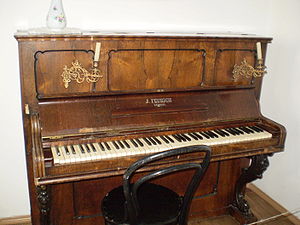
Feurich
Encyclopedia
Feurich was founded in 1851 in Leipzig by Julius Gustav Feurich and has been family operated for five generations becoming renowned for the quality of its pianos.
 Artisanal piano making is a great tradition in Saxony. The city of Leipzig was with Paris, London, and Vienna one of the pillars of European musical culture and music capital of the German Empire.
Artisanal piano making is a great tradition in Saxony. The city of Leipzig was with Paris, London, and Vienna one of the pillars of European musical culture and music capital of the German Empire.
In addition to the great cultural heritage, the city of Leipzig was also an excellent trading venue with a lot of national contacts and a prosperous middle class. Here Julius Gustav Feurich founded the piano factory Feurich in 1851.
By 1860 more than 400 instruments were manufactured and sold. Julius Feurich worked to expand his business and in the following years a larger and more modern factory was built allowing for ever greater quantities to be produced. By the turn of the century nearly 14,000 uprights and grand pianos were manufactured.
Feurich was one of the greatest German piano companies, but had the bad luck to be located in East Germany in a major city that was bombed to bits and the factory was destroyed in WWII then had the further misfortune to be behind the iron curtain during Germany's partition which caused exports to go near zero.
The factory was re-located to the outskirts of Gunzenhausen
in the 1960's.
Feurich pianos are in the same class as Bösendorfer
which is to say they have the highest quality and resale value. Unfortunately very rare today, as the entire piano business has suffered greatly.
History

In addition to the great cultural heritage, the city of Leipzig was also an excellent trading venue with a lot of national contacts and a prosperous middle class. Here Julius Gustav Feurich founded the piano factory Feurich in 1851.
By 1860 more than 400 instruments were manufactured and sold. Julius Feurich worked to expand his business and in the following years a larger and more modern factory was built allowing for ever greater quantities to be produced. By the turn of the century nearly 14,000 uprights and grand pianos were manufactured.
Feurich was one of the greatest German piano companies, but had the bad luck to be located in East Germany in a major city that was bombed to bits and the factory was destroyed in WWII then had the further misfortune to be behind the iron curtain during Germany's partition which caused exports to go near zero.
The factory was re-located to the outskirts of Gunzenhausen
Gunzenhausen
Gunzenhausen is a town in the Weißenburg-Gunzenhausen district, in Bavaria, Germany. It is situated on the river Altmühl, 19 km northwest of Weißenburg in Bayern, and 45 km southwest of Nuremberg. Gunzenhausen is a nationally recognized recreation area. The city was mentioned first in the...
in the 1960's.
Feurich pianos are in the same class as Bösendorfer
Bösendorfer
Bösendorfer is an Austrian piano manufacturer, and a wholly owned subsidiary of Yamaha. The brand is known for producing pianos with a uniquely rich, singing, and sustaining tone...
which is to say they have the highest quality and resale value. Unfortunately very rare today, as the entire piano business has suffered greatly.

